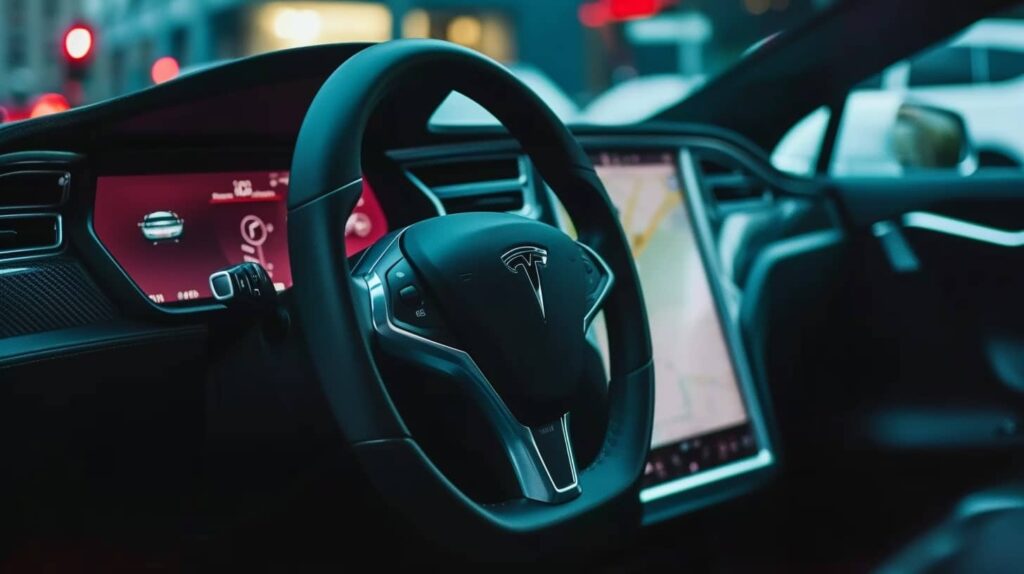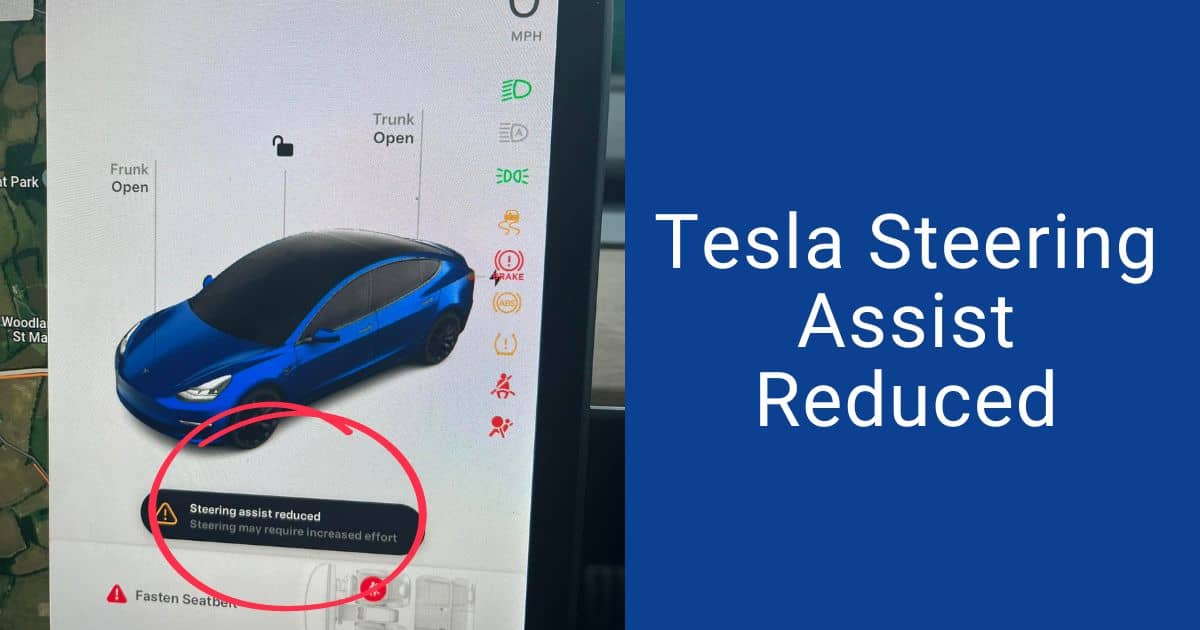Tesla’s Autopilot system is equipped with various driver assistance features. Among these features, “Steering Assist” is a crucial one. It allows the vehicle to help steer without human intervention. The degraded assistance in the steering is risky.
But why is the Tesla steering assist reduced? The steering assistance facility can be reduced for various reasons like issues with temperature sensors, battery power supply problems, bad connections, etc. Also, some other cases, like software updates and sensor damage, can degrade the steering assisting power.
In this article, we explore the mentioned causes in detail. We also find solutions to ensure your Tesla’s full performance mode.
Table: Causes & Quick Solutions of Tesla Steering Assist Reduced Issue
The table below provides you with an at-a-glance view of the causes and solutions regarding Tesla’s reduced steering assistance.
| Causes | Solutions |
| Issues with temperature sensors | Replacing the faulty sensor |
| Battery power supply problem | Charge the battery properly |
| Replacement of the battery if it is faulty | |
| Bad wire connections | Try to fix the visible disconnection issue |
| Take professional assistance | |
| Software updates | A soft reset |
| Take professional assistance | |
| Sensor damage | Replace the sensor |
Why Is Tesla Steering Assist Reduced? Reasons and Solutions

In this section, we discuss the causes of reduced steering assistance in Tesla in a detailed manner. We also elaborate on the solutions.
Temperature Sensor Issue
Temperature sensors are like guardians in electric cars. They keep a close watch on different parts of the vehicle. These sensors’ role becomes crucial when any component gets really hot or cold.
They help stop bad things from happening, like the battery getting too hot, the motor overheating, or the car’s power system breaking down. Following this, if the temperature sensor fails to detect the temperature, it results in degraded steering assistance for Tesla.
How to Fix?
The resolution of the temperature sensor issue is given below.
- Step 01: Purchase or borrow an OBD2 scanner, which is a tool used to diagnose issues.
- Step 02: Locate the OBD2 port under the dashboard near the steering column in your Tesla.
- Step 03: Plug the OBD2 scanner into this port. Ensure your car’s ignition is on but not running.
- Step 04: Run the scanner. If you get P0118 or P0126 code, it indicates that the temperature sensor is faulty.
- Step 05: Take your Tesla to an authorized workshop and get a replacement for the temperature sensor.
Check out this YouTube Video to learn how to use OBD2 scanned on Tesla:
Battery Power Supply Problem
The steering wheel assistance works appropriately when your Tesla’s battery can generate 12V. Any discrepancies in voltage generation lead to no or reduced assistance facility to the steering wheel.
In this dysfunctional process, the EV’s control module receives a low-voltage signal, reducing steering assistance.
How to Fix?
The following are the stepwise guidelines to resolve the problem with the battery voltage.
- Step 01: By using the Tesla App, go to the battery health section. Check whether it has sufficient charge or not.
- Step 02: If you find the charge is lower than the standard. Go for charging the battery.
- Step 03: Now, start driving in Autopilot mode and check the steering assistance’s condition.
- Step 04: If it is still not okay, then the battery needs to be replaced. So, go to a Tesla service center and replace the battery.
Bad Connections
Tesla’s power steering system has various complex wiring connections and groundings. If there is any issue with any of the connections, it can trigger reduced steering assistance.
How to Fix?
Here, we guide you in resolving the faulty connection issue.
- Step 01: Just casually do a visual inspection to detect any loose or torn wire connection. Fix that one.
- Step 02: If you cannot find any issue after the visual inspection, you must take the vehicle to a workshop that is authorized by Tesla. The professionals will fix the faulty connection issue.
Damaged Sensors
Tesla’s sensors are essential for your vehicle’s steering system to work correctly because they identify obstructions. And relay important data to the power steering control module.
One potential reason for a decrease in Tesla’s steering assistance is the interference or harm to the sensors. Sometimes, even encountering a road bump or getting too near another car can result in these sensors not working as they should.
Also, sometimes dirt can trigger malfunctions in the sensors.
How to Fix?
Below is a guideline to fix Tesla’s sensor issue.
- Step 01: First, several sensors in your Tesla, like a parking sensor, ultrasound sensor, etc. So, you need to identify which one is damaged.
- Step 02: Connect an OBD2 scanner to find out which sensor is causing the problem. Like, the P0101 code indicates that the Air Flow sensor is damaged.
- Step 03: Upon finding which sensor is faulty, you have to replace that one.
- Step 04: Open the Frank to see the sensors. Take out the faulty sensor and install a new one.
Software Update
Occasionally, your Tesla might encounter problems with its steering assist, which can be linked to software update glitches. If you’ve recently updated your car’s software and observed a decrease in steering assistance, the reason can also be the latest update.
How to Fix?
The following are the guidelines for resolving the issue with the software update.
- Step 01: First, you have to attempt a soft reset by pressing and holding the two scroll buttons on your steering wheel for a shorter period.
- Step 02: If it does not work, go to a Tesla-authorized workshop to get professional assistance.
People Also Ask
Here, we answer some relevant questions regarding the reduced assistance of Tesla’s steering performance.
Yes, you can continue to enjoy the benefits of Tesla’s Autopilot features. It includes adaptive cruise control, lane-keeping assistance, etc. But, it’s risky when the steering assistance is not working properly.
The long-term implications are related to enhancing safety while encouraging responsible driving. With reduced steering assist, the risk of overreliance on the system can generate potential safety concerns.
Yes, you can still use steering assist in your Tesla after the reduction in steering assistance. However, it’s crucial to use it responsibly and maintain control of the vehicle at all times.
Final Words
We hope that now you have a clear understanding of why Tesla steering assist is reduced. To resolve the matter, you can apply the given solutions. Here, in most of the solutions, we do not suggest applying the DIY approach in consideration of the vehicle’s sophistication.
Finally, if you suspect a problem with your Tesla’s steering assist, it’s advisable to contact Tesla’s customer support or visit a certified Tesla technician. We highly recommend not going to a conventional workshop as the mechanism is new, and most technicians need to become more familiar with it.

I am an experienced guide in electric mobility, offering clear and expert guidance for those venturing into the world of electric vehicles.
Through collaborations, research, and hands-on experience, I navigate readers through the evolving landscape of smart automobile technologies and the significance of renewables.

